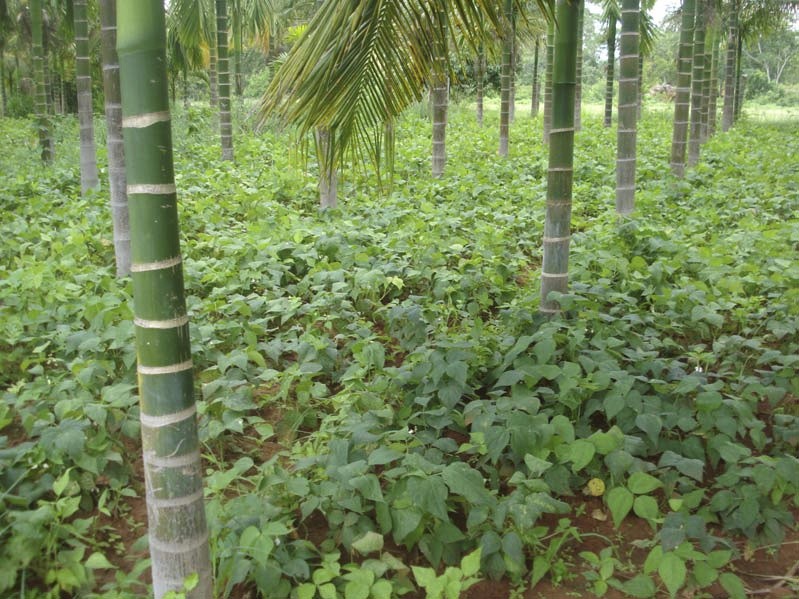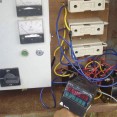
Shortages of water and energy and low crop yields are serious challenges in rural India. This project of the Asian branch of the International Energy Initiative (IEI) (www.iei-asia.org) demonstrated improved practices for sustainable agriculture to improve the food supply. Water use, and the energy for pumping, have been reduced through efficient pumps as well as focused water application through sprinkler and drip systems. The aggregated reduction of electricity use was more than 30% and the reduction of water use about 60% (in the monitored months).
In addition, substitution of chemical fertilizers with natural manure reduced the energy for fertilizer production and, combined with practices like crop-rotation, enhance long-term soil health. It is thus an integrative approach, combining efficient use of energy, water, and the soil.
Background
Over 715 million people in India are dependent on agriculture. They have neither the means nor the capacity for a viable alternative. The average farm size is very small; over 50% of all operational farms are smaller than one hectare. In addition, agricultural inputs such as water and fertiliser are in short supply or are expensive.
Surface water sources and rainfall are often inadequate for farming, with the result that many farmers use groundwater for irrigating their fields. To use the groundwater, farmers have to bear the costs of drilling the well and purchasing the pump. The actual running of the pump, however, has no associated cost because the state-owned utility companies are obliged by law to provide free electricity for agricultural pumping. The effect of this is that most farmers buy inexpensive, but also very inefficient, water pumps. The outcome: a very high demand for electricity for irrigation purposes. The electricity distribution system is often overloaded which, in turn, has negative effects on the power supply, such as inadequate voltage and shutdowns at times when irrigation is essential to farmers.
To address these problems, the Regional Energy Initiative Asia, as part of the International Energy Initiative (IEI), initiated this project to demonstrate the benefits of efficient resource use. The measures adopted included efficient water pumping and methods of organic soil enrichment. Farmers benefit from the reduced need for inputs as well as from higher income and improved livelihood. The state utilities also benefit, as the excess load is reduced.
For the implementation of the project, 50 small farms in the rural districts of Bangalore and Tumkur were chosen. Of these, 33 farms had deep wells fitted with electric pumps, one had a well fitted with a hand-pump and 16 farms were rain-fed only. At the start, the existing patterns of inputs to the fields (water, electricity for extracting groundwater and fertilisers) were observed both during land preparation and crop growing. Once the resource use was evaluated, a series of efficiency improvements were implemented. These included efficient water-pumping for irrigation, efficient water application through micro-irrigation (drip and sprinkler) systems and cost-effective and environmentally-beneficial soil enrichment activities.
After the implementation of the efficiency improvements was finished, the resource use was re-assessed. The results showed that the efficiency measures significantly reduced the resource use and also had positive effects on the living conditions of the local farmers.
Technology, Operations and Maintenance
During the project a number of different efficiency improvements were implemented. These included efficient water-pumping, efficient water application and cost-effective and environmentally-beneficial soil enrichment.
All the existing pumps on the 50 farms were replaced with new efficiency-certified multi-stage submersible pumps. These provide equivalent discharge but use much less power. In addition, the farm with only a hand pump was provided with a similar efficient electrically-powered pump and the 16 farms that did not previously have pumps were provided with shared access to four wells, each fitted with an efficient submersible electrically-powered pump. Overall, a total of 38 new efficient pumps were provided, lowering the demand for electricity by about 36%.

In addition, the farms were equipped with micro-irrigation systems that enable water conservation through controlled application and/or with sprinklers that simulate rain by spraying fine jets of water over the cropping area.
The drip systems allow water-application directly at the roots of the plants. The water is carried to the plant under low pressure through small diameter pipes and delivered to the roots by small emitters. While in the sprinkler system the water flows through nozzles and sprays over a larger area. Sprinkler technology is mainly used for short plants and on steeper terrain. Efficient irrigation systems now serve a total of 71.2 acres of farmland.
During the project the farmers were instructed on the correct installation and use of the equipment provided, but adequate local support and supply of spare parts has not yet been established.
The project team also encouraged the farmers to switch to a non-chemical system of soil nourishment. This is an on-going activity as only slow adjustments are possible at a time, to prevent the yield from falling in the first years and adversely affecting the farmers. So far three options have been adopted by the farmers: rotating the usual crops with a leguminous crop whose yield is for sale, inter-cropping of a plantation with plants for soil enrichment and generating natural manure in compost heaps.
Financial Issues and Management
The project was designed to demonstrate that paying for efficiency measures on farms is more beneficial than subsidising electricity and fertiliser. Therefore, the farmers did not have to contribute financially to receive the new equipment. Each kWh saved due to the installed efficiency measures accounts for monetary savings of €0.06 – €0.14, meaning that the payback period is estimated at approximately 4.5 years.
Environmental Issues
The project benefits the environment in multiple ways. On the one hand, the efficiency measures have already reduced the demand of water and electricity. On the other hand, the switch to natural fertiliser improves the soil quality and reduces the requirement for fossil fuels for manufacturing chemical fertilisers. Furthermore the replacement of 33 electrically-operated pumps with more efficient alternatives reduced the CO2 emissions by about 537,900 kg/year. Even accounting for the emissions generated by the five newly installed pumps, the total emission reduction for the project is as high as 407,300 kg CO2/ year.
Social Issues
The project helped 16 smallholders who were formerly restricted to rain-fed cultivation because they had no financial resources to install proper irrigation systems. These farmers, who previously only obtained a subsistence-level output, can now grow additional crops for sale and for family consumption.
Results & Impact
Several short-term and long-term impacts of the project have been identified. As well as the positive effects on the environment, the project has successfully demonstrated that subsidising the purchase of efficient equipment can significantly reduce resource use while, at the same time, enhance the food supply and income of local farmers.
Replicability
Theoretically the project design and technology have a good potential for replication. There are many farmers in India who either use inefficient pumps or have no access at all to irrigation systems. The required equipment is commercially available and the proposed watering and fertiliser practices can be easily adopted. However, the major problem will be how to finance the technology. One proposed option would be the redirection of state subsidies from financing resource use to supporting the purchase of efficient equipment or farmers.
Lessons learned
The reliability of energy availability (and thereby water supply) is essential for the productivity of the farms, as well as for the correct use of the equipment. During the project e.g. one new pump failed because it was switched on when the voltage was too low for its operation and two other motors burnt out when operated with excess voltage.
It has also become apparent that when a new technology is introduced to a region, local people must simultaneously be trained so that the technology can be maintained and repaired locally after the project itself has ended.
-> Download the detailed summary here!
Projects with same technology
Interconnected Mini-grids for Intensive Rural Electrification in Nepal (IMIREN)
Combined pico-hydro and PV systems for the electrification of 10 communities in the Andes
To demonstrate the benefits of renewable energies for generating electricity in isolated areas in Peru
Projects in same country